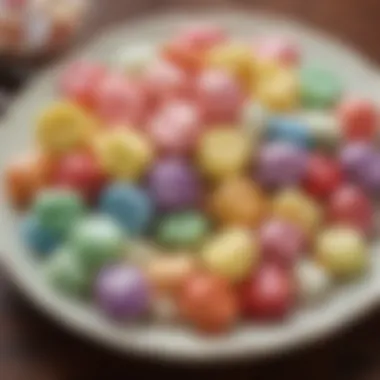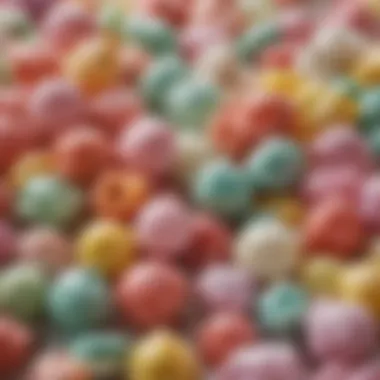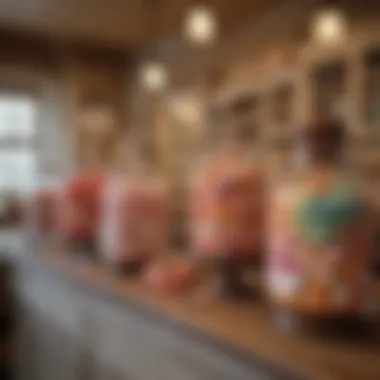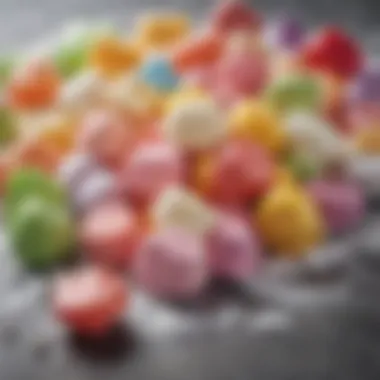Exploring the Craft of Gourmet Salt Water Taffy


Intro
In the kaleidoscopic world of confectionery, few treats evoke nostalgia quite like old-fashioned salt water taffy. This iconic candy, often associated with seaside towns and nostalgic boardwalks, offers not only a taste of sweetness but also a sensory trip down memory lane. It's more than just a sugary delight; it's a homage to craftsmanship, tradition, and a sprinkle of whimsy.
While the origins of salt water taffy can be traced back to the late 19th century, the allure of this chewy confection has never waned. As you delve into the history and art of crafting this gourmet treat, you'll uncover a tapestry woven with cultural significance, historical anecdotes, and culinary craftsmanship. From its humble beginnings to contemporary variations, salt water taffy has become a beloved staple that resonates with food lovers of all ages.
So, pull up a chair and get ready to embark on a tasty adventure exploring how this delightful candy is made and why it holds a special place in the hearts of many. Whether you're a seasoned candy maker or someone who simply enjoys the sweet things in life, understanding the nuances behind salt water taffy elevates your appreciation for this well-loved confection.
Prologue to Salt Water Taffy
When you think about comfort food, there are those dishes that evoke memories of simpler times or special moments. Salt water taffy is one such treat. Not just a sugary delight, it embodies a sense of nostalgia and craftsmanship that many modern sweets lack. The importance of diving into the art of old-fashioned gourmet salt water taffy is all about appreciating its rich heritage and unique flavors.
Definition and Characteristics
Salt water taffy is a chewy confection made primarily from sugar, corn syrup, butter, and, surprisingly, a little bit of sea salt. The addition of this salt is what sets it apart from other candies. While its name may suggest a distinct salty flavor, the salt primarily enhances the sweetness, creating a balance that is simply delightful.
When properly made, the texture of salt water taffy is a stretchier type of chew, often described as both soft and elastic. This is achieved through a meticulous process that involves cooking the ingredients to a specific temperature and then "pulling" the taffy, which aerates it and gives that classic chewy quality. Taffy's variety in flavor—from classic vanilla to adventurous blue raspberry—cater to a wide range of palates. Each piece wrapped in cheerful paper not only entices the senses but also showcases the colors that charm any taffy lover.
Cultural Relevance
The cultural significance of salt water taffy stretches far wider than its sweetness. Originating in coastal towns, particularly along the East Coast of the United States, this treat is often associated with summer vacations and seaside boardwalks. For many, a trip to the beach is not complete without a shop visit offering fresh taffy.
Moreover, salt water taffy reflects the creativity of local confectioners. Each region has developed its spin on flavors, often influenced by local traditions and ingredients. For instance, while some shops might offer seasonal flavors based on holidays or local festivities, others may combine unique regional flavors that tell a story of their own. This blend of nostalgia and local pride makes salt water taffy more than just a candy; it is a symbol of community.
"To savor salt water taffy is to take a bite out of history and culture, all while enjoying a sweet treat."
In summary, salt water taffy isn’t merely a candy but a celebration of tradition, creativity, and community spirit. Understanding its roots and appreciating its characteristics fosters not just enjoyment but also a connection to the cultural fabric of the regions it represents.
Historical Background
Understanding the historical background of salt water taffy provides valuable insight into its significance as both a beloved confection and a cultural artifact. Known for its chewy texture and delightful flavors, this sweet treat has a history that is not only rooted in tradition but also reflective of the times and places where it has flourished.
Salt water taffy is more than just a candy; it embodies the spirit of seaside charm and nostalgia. Its emergence is tied intricately to coastal towns in the United States, particularly during the late 19th century, when the popularity of boardwalks began to rise. The history of this delicacy is filled with local lore and anecdotal tales, enriching its appeal.
Origin of Salt Water Taffy
The origin story of salt water taffy is steeped in myth and lore, with one of the most well-known tales tracing back to a young candy maker in Atlantic City, New Jersey. As the story goes, a vendor named David Bradley had his cart of taffy soaked by ocean water during a storm. Instead of discarding the ruined candy, he cheekily labeled it "salt water taffy." This clever marketing ploy drew in curious customers, turning a mishap into a local specialty.
While this narrative has become a staple of candy folklore, it's essential to recognize that salt water taffy thrived in an era of burgeoning tourism. The late 1800s saw an increase of visitors flocking to the beaches, eager to indulge in local treats. It was during this period that taffy began to be mass-produced, reaching a wider audience and solidifying its status as a classic beachside confection.
Evolution Over Time
As time marched on, salt water taffy continued to evolve, adapting to the changing tastes and preferences of consumers. The turn of the 20th century brought about advancements in candy-making technology, enabling manufacturers to refine their techniques. Batch cooking methods gave way to quicker, more efficient approaches, allowing for a wider variety of flavors and textures.
In the mid-20th century, with the rise of supermarkets and the decline of local candy shops, salt water taffy's accessibility transformed. No longer confined to coastal towns, this treat made its way inland, appealing to a broader demographic. Modern consumers seek unique flavors and organic ingredients, prompting a return to artisanal methods among some candy makers.
Today, salt water taffy has seen a resurgence within the realm of gourmet treats, showcasing inventive flavors like lavender rosemary or spiced mango. This evolution reflects a broader trend in the food industry as people seek out high-quality, handcrafted products. The connection between old-fashioned techniques and modern creativity continues to define the legacy of this enchanting candy.
"Salt water taffy's journey from a seaside mishap to a gourmet delight encapsulates the timeless appeal of nostalgia intertwined with innovation."
The historical background of salt water taffy not only highlights its roots but also illustrates its ability to adapt and thrive in changing times. This sweet story adds to the rich tapestry of American culinary heritage, ensuring that the art of making gourmet salt water taffy remains a celebrated tradition.
Key Ingredients in Gourmet Salt Water Taffy
In the realm of gourmet salt water taffy, the ingredients used are not just mere components—they are the heart and soul of this beloved confection. Understanding their roles lays the groundwork for mastering this artisanal craft. Each ingredient not only contributes to the delightful taste and texture, but they also carry historical significance that adds depth to this sweet treat.
Sugar Types and Their Roles
Sugar serves as the foundational element in gourmet salt water taffy. However, not all sugars are created equal. Different varieties of sugar can change the character of the taffy significantly. For instance, using granulated cane sugar gives a classic sweetness and texture, while light corn syrup contributes to a smoother finish and helps prevent crystallization.
As candy makers whip up their creations, many may also turn to brown sugar or honey for a richer flavor profile. The use of organic sugars has gained traction, appealing to health-conscious consumers who favor less processed options.


- Granulated Cane Sugar: Offers a traditional taste and balanced sweetness.
- Corn Syrup: Ensures a gooey, chewy texture while reducing unwanted crystallization.
- Brown Sugar: Adds depth and complexity with its caramel notes.
- Honey: A natural sweetener that introduces unique flavor nuances.
The choice of sugar can drastically affect how the taffy holds its shape and absorbs flavors, making this an essential area of focus for any homemade or boutique confectionery enthusiast.
Flavorings and Extracts
Flavors breathe life into gourmet salt water taffy, transforming it beyond its sugary origins. While traditional options like vanilla and strawberry remain popular, modern twists have expanded the universe of delectability. Artisans are now experimenting with flavoring extracts ranging from lavender to spicy chili, catering to a more adventurous palate.
Delicate balance is key—stronger extracts must be used sparingly to avoid overpowering the delicate sweetness. Common options include:
- Vanilla Extract: Enhances the overall flavor with warmth and sweetness.
- Fruit Extracts: Offer vibrant, fresh flavors reminiscent of summer.
- Spice Infusions: Uncommon flavors such as peppermint or cinnamon create exciting surprises.
Artisans often blend flavors to craft signature taffy varieties that speak to local cultures or seasonal themes. For example, a seaside shop might incorporate seaweed extract to evoke the region's coastal ambiance, improving the local culinary landscape.
The Significance of Sea Salt
Ah, the pièce de résistance—sea salt. It might seem counterintuitive to add salt to something sweet, but it plays a pivotal role in elevating the experience of salt water taffy. The contrast of sweet and salty creates a complex flavor profile that tantalizes the taste buds.
- Flavor Enhancement: Sea salt amplifies the sweetness without being overpowering, adding a gourmet touch that enhances the overall experience.
- Texture: Added as large flakes or finely ground, sea salt can create a delightful crunch, making each bite an adventure.
- Health Perception: Many consumers deem sea salt to be a healthier alternative to standard table salt, as it is often less processed and contains trace minerals.
"Salt is not just a seasoning; it is an essential ingredient that helps form a symphony of tastes in gourmet taffy."
Traditional Methods of Preparation
The art of creating old-fashioned gourmet salt water taffy is steeped in tradition. These methods not only highlight a connection to a sweet past but also ensure that every batch crafted embodies flavor and texture. Emphasizing traditional methods provides deeper insight into the time-honored techniques that shape this beloved treat. It’s not mere confection making; it's part of a culinary legacy that connects generations.
Batch Cooking Techniques
Batch cooking represents the heart of taffy preparation. In this process, sugar, corn syrup, and water are heated together in a large pot to a precise temperature. The importance of this stage lies in achieving the right consistency. Too high a temperature can lead to a brittle product, while too low means the taffy could end up too chewy or sticky.
Some artisans prefer using copper kettles instead of modern pots, believing that they distribute heat more evenly. This can yield a smoother texture in the final product.
- Ingredients Preparation:
- Heating and Cooking:
- Cooling Off:
- Measure the sugar and corn syrup accurately.
- Add salt and flavorings at just the right moment.
- Use a candy thermometer to monitor the temperature.
- Stir gently to prevent the sugar from scorching.
- Pour the mixture onto a marble slab or a Silpat mat to cool.
- Allow the taffy to rest until it’s manageable for pulling.
Batch cooking translates into a considerable difference in quality when it comes to salt water taffy. The carefully controlled environment means homemade taffy can rival even the best commercial offerings, providing an authentic and rich experience.
Pulling and Stretching Process
The pulling and stretching of taffy is as crucial as the cooking itself. This step integrates air into the candy, giving it that signature texture that distinguishes a good taffy from a great one.
- The Pulling Process:
This involves working the cooled taffy by hand. Traditionally, this was done using hooks or even just bare fingers. As the taffy is pulled, time and again creating a silky, glossy surface, air gets trapped within, creating a lightness that is desired. - Techniques to Master:
- Significance of the Stretch:
The act of pulling changes the crystalline structure of the sugar, leading to a chewy texture that melts in the mouth. While some prefer it primarily based on tradition, the method’s science cannot be overlooked; a well-pulled taffy is the hallmark of craftsmanship.
- Start with smaller pieces and work them by hand until they start to cool.
- Gradually increase the size of the portions, using the palms of your hands to stretch and fold the taffy.
"The joy of taffy lies in its texture, its chewiness, and the memories it conjures. It’s more than just candy; it's a craft passed down through the ages."
Traditional preparation techniques create not just a confection but a moment in time. Those who partake in making or enjoying this taffy can savor the craftsmanship of yesteryear, a sentiment echoed across generations.
Modern Variations of Salt Water Taffy
The world of salt water taffy has seen a transformation that reflects the changing tastes of consumers. No longer confined to the traditional recipes of yesteryear, gourmet taffy makers now embrace a spectrum of innovative flavors and health-conscious trends. This modern adaptation not only keeps the classic confection relevant but also enhances its appeal to a broader audience.
Incorporating Innovative Flavors
In the realm of flavors, the artistry of salt water taffy has expanded beyond the basic vanilla or chocolate. Today, taffy enthusiasts can find a universe of options that cater to diverse palates. From sea salt caramel to lavender honey, the infusion of unexpected ingredients opens a gateway to culinary creativity. Artisan taffy makers often experiment by integrating local ingredients or seasonal produce, giving rise to flavors like blood orange or spicy jalapeño mango. This not only tantalizes the taste buds but also offers a unique experience for consumers.


Additionally, flavor combinations that tempt the adventurous include unexpected partnerships like bacon maple or matcha green tea. These choices challenge the norm and invite both nostalgia and curiosity, stimulating discussions among friends and family about their sweets.
"Exploring flavors is like a culinary treasure hunt; each bite uncovers a delightful surprise."
Health-Conscious Adaptations
As the health landscape shifts, so does the method of preparing gourmet salt water taffy. Many producers are beginning to pivot towards recipes that respect health considerations without sacrificing flavor. For instance, sugar alternatives such as agave nectar, coconut sugar, and even stevia are finding their way into taffy formulations. This opens avenues for those mindful of their sugar intake, while still allowing them to indulge in a sweet treat.
Furthermore, gluten-free options are also emerging as a standard offering. Traditional taffy recipes inherently do not contain gluten, but marketing them as such can attract consumers with dietary restrictions. Options enriched with protein or made with natural colorings and flavorings are becoming more prevalent, appealing to a health-conscious demographic eager for guilt-free indulgence.
Whether by embracing modern culinary trends or catering to dietary needs, the contemporary variations of salt water taffy stay true to their roots while welcoming new audiences into the fold.
Regional Differences in Taffy Production
When it comes to the ever-tempting world of gourmet salt water taffy, the regional differences in production stand out like a colorful candy stripe. The art of making this sweet delight varies not just in technique but also in flavor profiles, driven by the geographical influences and cultural approaches of each area. Understanding these differences enhances one's appreciation for this confectionery and offers insight into the culinary niches that define diverse communities.
East Coast vs West Coast Styles
The East Coast and West Coast present distinct styles in the production of salt water taffy, each with unique flavors and textures that reflect their regional origins. East Coast taffy, particularly prevalent in places like Atlantic City, is often softer, sweeter, and chewier. The traditional methods used are deeply rooted in history, where generations of confectioners have perfected the craft. Local suppliers typically champion classic flavors such as vanilla, butter, and strawberry, aiming for a nostalgia-inducing experience that dances on the palate.
Conversely, taffy from the West Coast leans towards a bolder flavor palette. Regions like Santa Monica may incorporate more innovative ingredients, resulting in eccentric offerings such as chili mango or matcha. The texture is often slightly firmer, almost akin to a satisfying workout for the jaw. There’s a general vibe of experimentation here, with many taffy makers eager to push boundaries while paying homage to traditional methods.
Here’s a quick rundown of some typical contrasts:
- East Coast:
- West Coast:
- Textures: Softer, chewier
- Flavors: Vanilla, butter, strawberry
- Cultural Influence: History and nostalgia
- Textures: Firmer, crunchier
- Flavors: Chili mango, matcha, salted caramel
- Cultural Influence: Innovation and experimentation
These variations highlight not only the differences in style but also the cultural identities tied to each coastline. Whether one prefers the tried and true traditions of taffy-making or the inventive twists of its counterparts, there is a depth of flavor and technique that beckons connoisseurs to explore.
Cultural Influences on Flavors
The flavor profiles of gourmet salt water taffy aren't just random; they are the direct result of cultural influences that shape local palates. Various communities contribute their unique culinary history and taste preferences, resulting in a delightful array of treats that shine in their own right. For example, the use of local fruits and spices often influences flavors, leading regions to celebrate their agricultural bounty in taffy form.
In New England, you might find blueberry and cranberry taffy that showcases the luscious local fruits. Meanwhile, on the West Coast, adventurous flavors like mojito or even sriracha taffy push the boundaries of what should be a traditional treat. It's a true melting pot of creativity!
Moreover, the cultural events and festivals in specific locations serve as additional sources of inspiration. Seasonal offerings like pumpkin spice taffy during the fall in places like Vermont allow the sweet to reflect the time of year, creating excitement and anticipation around local treats that evoke memories and traditions.
"Flavors are not just tastes; they are stories we tell with our senses. In taffy, these tales are mingled with the local culture and history of our communities."
In essence, the variations in salt water taffy are a testament to the rich tapestry of cultures across America. From classic recipes to the bold flavors that astonish the senses, understanding these regional differences is vital for any true taffy aficionado.
The Role of Taffy Shops in Local Economies
Taffy shops, those inviting little establishments often found lining boardwalks and busy streets, are more than just places to satisfy a sweet tooth; they serve as important cogs in the machinery of local economies. Their impact can be felt not only in the realm of confectionery but in the broader context of community engagement and economic vitality. The delightful aroma of freshly pulled taffy and the bright, cheerful decor can create an atmosphere that draws in foot traffic, transforming casual passersby into loyal customers.
Small Business Impact
Taffy shops often function as small businesses that embody the spirit of entrepreneurship. These shops typically serve as family-run operations, infusing local culture and character into their product offerings. The folks behind the counter know their craft well—mixing flavors and creating artisanal experiences that stand out in a crowded marketplace. Here are some key impacts they have on local economies:
- Job Creation: Taffy shops employ local residents, providing job opportunities, particularly for students and part-time workers. Each position, from candy maker to cashier, helps keep the local employment rate steady.
- Supporting Local Suppliers: Many small taffy shops strive to source materials from local suppliers when possible. This practice boosts nearby farmers and vendors, creating a supportive ecosystem that fosters mutual growth.
- Community Engagement: Taffy shops often engage in local events—be it fairs, festivals, or parades. Their participation contributes to a sense of community and belonging, drawing more visitors who may discover other local businesses in the process.
When consumers choose to spend their money at these quaint establishments, it can result in a ripple effect, fostering a vibrant small business culture that sustains and enhances the local economy.
Tourism and Taffy Production
Tourism plays a significant role in the success of taffy shops. These establishments often become tourist spots, especially in beach towns or urban areas known for their culinary delights. Here's how tourism interweaves with taffy production:
- Attraction for Visitors: Iconic taffy shops become attractions themselves, drawing visitors eager to experience the nostalgia of traditional candy-making. They often share space with other tourist-friendly venues, creating a lively marketplace atmosphere.
- Unique Cultural Experience: Tourists are not just looking for any sweet treat; they seek a taste of local flavor, something that tells them about the region. Taffy shops provide that narrative through their artisanal recipes and innovative flavor combinations, making them memorable parts of travelers' adventures.
- Boosting Seasonal Revenue: The seasonal fluctuations in tourism can significantly impact taffy shop revenues. Summers may see a spike as families flock to beaches, eager to grab that iconic salt water taffy that brings smiles to their children’s faces. This can sustain the shop through leaner months.


"In the heart of every taffy shop lies a unique story, waiting to be shared with every bite of candy."
This sentiment flows through the air in taffy shops, impacting not just their own success but the very fabric of local economies as well.
Making Taffy at Home
Making taffy at home is not just a culinary project; it’s a journey back in time where you get to play with flavors and create something delicious while enjoying the process. There’s something special about rolling up your sleeves and engaging with the sticky world of taffy. It invites a sense of old-world charm and hands-on craftsmanship that is often lost in the hustle of modern food production. Plus, the benefits of crafting your own taffy extend beyond mere taste; it's an experience that can foster creativity and provide a sense of accomplishment when you finally pull your creation.
Not only does making salt water taffy at home allow for customization tailored to personal flavor preferences, but it also offers insights into the candy-making process itself. Getting cozy with the techniques can help demystify the art of candy making, leading you to appreciate the craftsmanship behind gourmet treats sold in stores. The kind of salt water taffy you create often becomes more than just candy—it transforms into a memory stitched together with laughter shared with friends or family in the kitchen.
Essential Tools Required
Before embarking on this sweet adventure, ensure you have the proper tools at your disposal. Here’s a handy list of essential items:
- Large Pot: For boiling sugar and mixing ingredients. A heavy-bottom pot prevents scorching.
- Candy Thermometer: To accurately measure the temperature of the sugar syrup. Too hot, and your taffy may turn brittle.
- Sturdy Wooden Spoon: For stirring the taffy mixture during cooking.
- Marble Surface or Silicone Mat: Ideal for pouring out your hot taffy and working your magic.
- Greased Hands: This might seem odd, but having oily hands can help prevent taffy from sticking, making it easier to work with.
- Wrapping Paper: Once you’ve made and cut your taffy, it’s essential to have something to wrap it in to keep it fresh.
- A Helper: While it's possible to make taffy solo, having a friend lend a hand can make things far easier, especially during the pulling and stretching phase.
These tools form the backbone of an enjoyable taffy-making experience. Gather all items before getting started to ensure a smooth operation.
Step-by-Step Recipe Guide
Creating your own gourmet salt water taffy not only satisfies your sweet tooth but also allows for a flexible approach to flavors. Follow this step-by-step guide for a straightforward approach to making taffy at home:
- Ingredients Check: Ready your ingredients: 2 cups granulated sugar, 1 cup corn syrup, 1/2 cup water, 1/4 teaspoon sea salt, 1 teaspoon flavoring of choice (like vanilla or fruit extracts), and some food coloring (optional).
- Mix Ingredients: In a large pot, combine the sugar, corn syrup, water, and sea salt. Stir lightly to dissolve the sugar.
- Heat Mixture: Heat the pot over medium heat. Keep an eye on it and use the candy thermometer to monitor the heat. When it reaches 250°F, it's time to move to the next step.
- Flavor and Color: Once the mixture hits the desired temperature, remove it from heat. Stir in your chosen flavor and a drop of food coloring, if using. Ensure it’s mixed thoroughly but be careful, as the mixture will be hot.
- Pour Out Taffy: Quickly pour the mixture onto your greased marble surface or silicone mat. Let it cool for a few minutes until it’s handleable but still warm.
- Pulling and Stretching: Grease your hands to prevent sticking. Grab the edges of the warm taffy, and start pulling it. It may be a bit of a workout, but it’s a crucial step for achieving that fluffy, airy texture. You should pull and fold repeatedly until it becomes less sticky and takes on a shiny appearance.
- Cutting the Taffy: Once the taffy is cool enough to handle and has a shiny finish, form it into a log shape. Use a knife to cut your taffy into bite-sized pieces.
- Wrap Up: Finally, wrap each piece individually in parchment paper or wax paper to keep it fresh. Store in an airtight container.
Making salt water taffy at home can be both a labor of love and a delightful exploration of flavors. It’s an artistic endeavor with a delicious payoff and a rewarding hobby. Don’t be shy about experimenting with various flavorings—after all, what’s taffy without a bit of whimsical creativity?
"Candy is dandy, but taffy is a whole other world of flavor and fun."
Try this endeavor out and share a piece of your crafted nostalgia with friends or family!
The Science Behind Taffy Texture
Understanding the science behind taffy texture is crucial for anyone keen on mastering the art of making old-fashioned gourmet salt water taffy. The soft, chewy consistency that many desire depends on how the candy components interact during preparation. The balance of ingredients and the techniques used play a pivotal role in creating that perfect taffy bite—not too hard, not too gooey. This balance ultimately affects the overall enjoyment and can distinguish gourmet taffy from mass-produced varieties.
Understanding Candy Chemistry
Candy making, particularly with taffy, is both an art and a science. At its base, taffy consists mainly of sugar, fat, and water, but how these elements combine determines the final product's texture.
- Sugar Crystallization: The type of sugar used can alter the consistency. For instance, the incorporation of corn syrup or glucose syrup helps prevent crystallization of sugar, leading the taffy to maintain a smooth texture.
- Starches and Gums: Some recipes may include starches or gums to improve chewiness and give that desired elasticity. These additives create a unique mouthfeel which enhances the overall experience.
- Interaction with Water: The way water interacts with sugars affects its boiling point, which is critical for achieving the correct consistency. Boiling the mixture to the right temperature ensures the sugar dissolves fully, forming a pliable structure once cooled.
"Candy making is a delicate balance of chemistry and intuition. Get it right, and you create bliss in a bite."
Importance of Temperature and Consistency
Temperature plays a starring role in candy making. Different temperatures can yield entirely different results, particularly in taffy production. Here are a few considerations:
- Boiling Temperature: Taffy is usually cooked to hard ball stage, around 250°F (121°C). This precise temperature is critical; too low means a gooey mess, while too high results in a hard, unchewable product.
- Cooling Phase: Once the desired temperature is reached, the mixture must cool slightly before being pulled. This phase is crucial; it's where the texture begins to take shape, enabling the fibers to set as they cool.
- Executing the Pull: The pulling process introduces air into the taffy, lightening its texture. The longer and more vigorously it is pulled, the lighter and chewier it becomes.
By adhering to these considerations of temperature and building on the candy chemistry, anyone can develop a deeper appreciation for what goes into making delicious, gourmet salt water taffy. As they say, the proof is in the pudding—or in this case, the taffy!
Closure
In looking back through the layers of history and culture, we unveil just how important old-fashioned gourmet salt water taffy remains in the arena of confectionery. This sugary delight has found a cherished spot not only in the hearts of those who enjoy its distinct chewy texture but also in the broader culinary narrative that binds traditions and modernity.
The Timeless Appeal of Taffy
The allure of salt water taffy is actually deeply rooted in nostalgia and memories. Every piece tells a story, be it from a summer trip to the beach or a visit to a local taffy shop that might’ve been around for generations. Its unique texture, both tender and resilient, coupled with a medley of flavors, resonates with people of all ages. The varying tastes – from classic vanilla and chocolate to adventurous sea salt caramel – keep enthusiasts coming back for more.
"Taffy isn’t merely candy; it’s a vessel for memories, transporting us back to carefree days gone by."
Beyond flavor and fun, the craft of making taffy showcases a meticulous balance of science and artistry. The process requires not just skill but also an understanding of candy chemistry, which allows the creators to innovate while holding onto time-honored techniques. It’s this dedication that instills a sense of authenticity in every chewy bite, making taffy a timeless treasure.
Future of Gourmet Salt Water Taffy
As we pivot toward the future, the landscape of gourmet salt water taffy is ripe for evolution. With an increasing focus on health and sustainability, many new taffy makers are experimenting with organic ingredients, offering vegan options or reducing sugar levels without sacrificing taste. These adaptations cater to an ever-growing audience that values conscience alongside pleasure.
The role of social media cannot be overstated either. Platforms like Instagram and Facebook create avenues for small taffy shops to showcase their artisan products to a global audience. This interaction not only boosts visibility but also allows for a sharing of unique flavors and techniques that cross coastal and geographical lines. As customer preferences shift, who can say what kinds of innovative flavors or methods might arise next?
In summary, old-fashioned gourmet salt water taffy is not simply an edible treat but a charming bridge from past to future, intertwining tradition with innovation, ultimately preserving its cherished place in the modern culinary scene.















